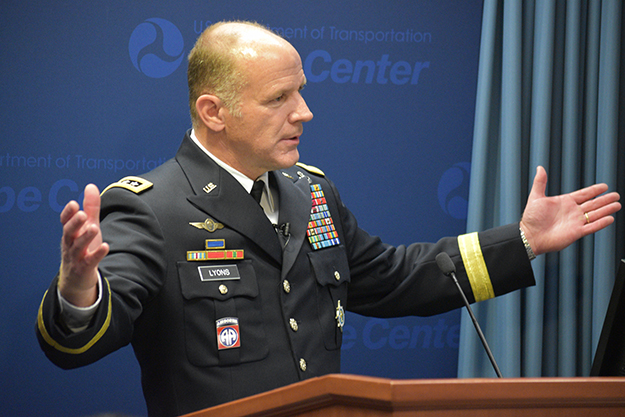Globally Integrated Logistics and the Changing Character of War

Above: General Stephen R. Lyons, commander of the United States Transportation Command, speaks during the U.S. DOT Volpe Center’s 2019 thought leadership series, Our New Mobility Future. (Volpe photo)
“There has been a proud history between the Department of Defense and domestic transportation, [and that] relationship has been long and steady,” said General Stephen R. Lyons, the 13th commander of the United States Transportation Command (USTRANSCOM). General Lyons spoke September 17 on “Globally Integrated Logistics and the Changing Character of War” as part of the U.S. DOT Volpe Center’s 2019 thought leadership series, Our New Mobility Future.
Prior to General Lyons’ talk, Acting Under Secretary of Transportation Joel Szabat signed an updated Memorandum of Understanding (MOU) between the U.S. Department of Defense (DOD) and U.S. DOT regarding the U.S. DOT Volpe Center.
The MOU, signed on behalf of DOD by Ellen M. Lord, Under Secretary of Defense for Acquisition and Sustainment, reinforces the important cross-departmental collaboration and long-standing partnership between federal agencies and the Volpe Center’s support to DOD’s mission across commands and offices.
Transportation is such a crucial component of the U.S. military’s ability to meet its global commitments that it is the sole focus of 1 of the 11 Unified Combatant Commands in DOD. USTRANSCOM is responsible for the coordination of people and transportation assets to allow the U.S. to project and sustain forces whenever, wherever, and for as long as they are needed. It provides support to the 10 other U.S. combatant commands, the military services, defense agencies, and other government organizations, and is the single manager of the U.S. global defense transportation system.
USTRANSCOM also maintains close links to civilian counterparts, including modal agencies within U.S. DOT.
Vital Link to Commercial Transportation
“There are…domestic ties to the Department of Transportation in every single sector,” said General Lyons. “We interface on a regular basis to ensure that the Department of Defense and our joint force has the ability to project from the continental United States.”
Though USTRANSCOM was established in 1987, the history of our military’s transportation activities goes back hundreds of years and includes maritime operations in the 1700s and use of railroad transport in the 1800s.
In addition, President Dwight Eisenhower’s support of the Federal-Aid Highway Act of 1956 led to the creation of the Interstate Highway System and realized Eisenhower’s vision of a strategic network of highways capable of moving materiel and troops in time of war.
Applying Transportation Advances to Department of Defense Challenges
“Conveyances aren’t much good unless we have nodes and routes to connect them to,” General Lyons said. “This network of both military enroute capabilities, as well as commercial trade routes, gives us tremendous flexibilities.”
However, this connection to public infrastructure and commercial industry means that operation and ownership of ports, conveyances, and the overall supply chain makes for both a diverse, capable, and flexible asset, as well as a potential risk due to the wide range of intricate dependencies, he said.
Transportation advances can be rapidly and readily shared between the military and commercial segments.
“I see the commercial industry leading in the technology frontier when it comes to logistics and logistics innovation,” General Lyons said, in terms of the commercialization of military transportation innovations. “The equities that you have on the future of industry are the same equities I have: to make sure that we have a viable, vibrant industry in the aviation world, in the sealift world, railways, et cetera.”
Change Is Constant
“The character of war and the character of logistics that has to keep pace with operations is changing dramatically,” General Lyons said. “The purpose of why we exist is what doesn’t change.”
As DOD works to project and sustain combat power on a global scale, threats such as contested lines of communication and advanced weapons join a growing list of drivers of the DOD logistics value chain.
Weapon system advances such as those with a reduced logistics footprint combined with technological progress in other fields such as automation and outer space present opportunities for USTRANSCOM.
“Space is in everything that we do, whether it’s sensing [or] communications,” General Lyons said. “And it’s also becoming more contested and congested.”
Automation is already playing a significant role in the military, and USTRANSCOM’s project portfolio includes unmanned aerial tankers for refueling aircraft in flight.
General Lyons also pointed out some current cautions related to automation and artificial intelligence.
“There are some challenges,” General Lyons said, “not just in terms of culture, but in terms of what happens if everything doesn’t go exactly as the algorithm said it was going to go—how do we respond to that?”
He also explained that much of the military’s core mission will not be done by machines alone.
“Anytime you’re talking about warfare…it’s inherently a human activity and will always be a human activity by its fundamental nature,” he said.
The longstanding ties between DOD and transportation will continue steadily into the future.
“Much of our mobility infrastructure today has been shaped by the need for national security and to move our forces,” said General Lyons. “We recognize that the security environment is changing quite rapidly, [and] we’re inextricably linked to…the viability of a commercial industry that we can rely on for national security needs in the future.”

